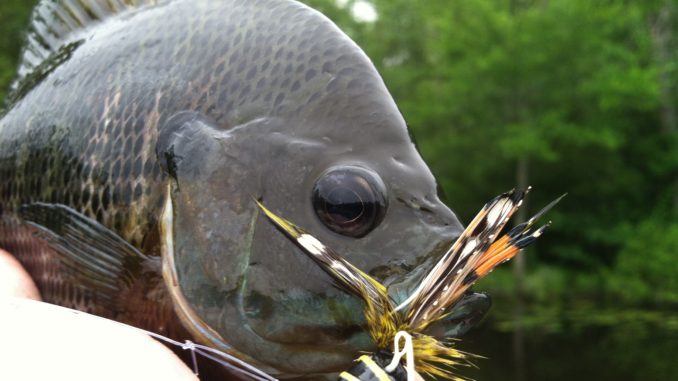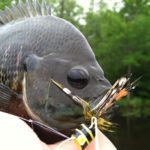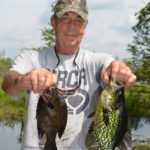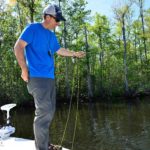
Popping bugs are deadly on summer bluegill
Deep in the heart of every southern angler’s roots is the beginning of a lifelong journey to catch fishy foes in flooded landscapes. Some cut their teeth along oyster-lined shorelines. But many got their feet wet with hand-sized copperhead bluegill on the end of their line in ponds, rivers and other lily pad-infested waters. And what better way to catch them than on top with a popping bug.
Bluegill are among the most-abundant freshwater fish in our waters across the country. They thrive in moving- and still- water systems, where an omnivorous diet enables them to eat nearly anything they can catch. For the most part, small fish and insects comprise their daily intake. And they will take them anyway they can get them. They will eat plenty of small fish. But insects are much easier to catch and pack a serious nutritional punch in a small package.
While small fish are a wintertime staple, spring and summer bring insects out of hiding. And there isn’t a better place to find a juicy insect than along the water’s edge. Bluegill will have their eyes peeled in those areas, ready to slurp the surface for an energy-packed bite.
As the summer heats up, so does the bream bite
Anglers looking for a must-do summer attraction need to know the bream bite ramps up in June and July. One who takes advantage is Mitchell Blake. He runs Fish IBX Charters out of his Chocowinity, N.C., home, guiding on the creeks and rivers on the west side of the Pamlico Sound.
“You can have some of the most fun you are ever going to have fishing. You can’t substitute it,” said Blake (252-4995-1803). “Get the right setup, in the right area, and you are golden.”
Many anglers who live in the flatlands of North Carolina and South Carolina’s coastal plain are keyed in on saltwater fish right now. But the hundreds of thousands of acres of freshwater rivers, creeks and sloughs are rich in forage and offer tremendous opportunities for bluegill.
Multiple rivers offer great bluegill action
The Cooper, Edisto, and Pee Dee river basins in South Carolina and any of North Carolina’s eight coastal river basins are all paradises where anglers can sling a lightly weighted topwater bug.
“There are so many places to fish in eastern North Carolina. But I love fishing the Three Sisters’ area off the Roanoke, the Cashie, and the lower Roanoke area around Jamesville,” he said. “It’s the prettiest place on Earth. And it’s full of fabulous places to catch big bream on popping bugs.
“We catch bluegill all summer. But we catch more in June than any other time. They are bedding, and we find them in huge numbers huddled up in their bedding habitat.”
Blake looks for places with sandy bottoms next to the shoreline, with lily pads and some other structure around.
“I like sandy bottom sections in 4- to 5-foot water. In most of the rivers we fish, the water falls off pretty quick,” he said. “We usually find them just off the bank, usually no more than 5 to 10 feet away from the edge, right above the ledge.”
Bluegill prefer firm, sandy bottoms to build their beds. They will congregate in huge schools during spawning season. Baits and lures presented above or in these spawning grounds are easy targets for bluegills.
Always be on the lookout for new bedding areas
While Blake knows where most of spawning grounds are in the waters he fishes, he will often ease down the bank on his trolling motor, looking for new areas of beds. And some stretches of water will bring better success than others as conditions change throughout the day.
“Sometimes when the wind shifts and a once-still creek starts to flow, it fires off, and the fish will go ballistic,” he said.
Bluegill will eat just about anything during their normal business operations. But they will ramp up their feeding when something edible appears in their spawning areas. Blake prefers a 4-weight fly rod to fish popping bugs.
“I love to use a black and yellow popping bug. If they are jamming it, that is all I will use,” he said. “But the white or glow color is a good second choice.”
Blake casts to banks in the vicinity of the beds and works the popping bug with sharp but short tugs every 3 to 5 seconds. A combination of the noise, vibration and surface disturbance is perfect for enticing a strike from a big, bedding bluegill.
Let the lure do its thing
“Roll the bug on the edge of the pads or in a hole along the shoreline, let sit for a few seconds, and then work it gently. Don’t work it too hard. Just allow the lure to do its job,” he said.
Often, anglers will cast a number of times to the same beds before drawing fish to the surface.
Bluegill are not only fantastic table fare, they can put a grin on any angler’s face when one tugs on the other end of the line. And the summertime topwater bite is an experience like none other. It produces an intense adrenaline rush to every angling type.
Click here for tips on bluegill fishing from a kayak.






